On the Multidisciplinary Design of a Hybrid Rocket Launcher with a Composite Overwrapped Pressure Vessel
Abstract
:1. Introduction
1.1. Hybrid Rocket Engines
- Advantages
- 1.
- enhanced protection from explosion or detonation during fabrication, storage, and operation;
- 2.
- start–stop–restart capability;
- 3.
- relative simplicity, which may translate into low overall system cost when compared to liquid bi-propellant engines;
- 4.
- higher specific impulse than solid rocket engines and higher density-specific impulse than liquid bi-propellant engines;
- 5.
- the ability to smoothly change thrust over a wider range of demand.
- Disadvantages
- 1.
- mixture ratio and hence specific impulse may vary during steady-state operation (as well as during throttling);
- 2.
- relatively complicated fuel geometries with significant unavoidable fuel residues (slivers) at the end of the burn, which somewhat reduces the mass fraction and can vary if there is random throttling;
- 3.
- prone to large-amplitude low-frequency pressure fluctuations (termed chugging);
- 4.
- relatively complicated internal motor ballistics resulting in incomplete descriptions, both of regression rates of the fuel and of scaling effects, affecting the design of large hybrid systems.
1.2. Composite Overwrapped Pressure Vessels
2. Modelling Approaches
2.1. Propulsion Modelling
2.2. Mass and Sizing
2.3. Aerodynamics and Stability Modelling
2.4. Tank Modelling
3. Multidisciplinary Design Optimisation
3.1. MDO Architecture
3.2. Constraints
3.3. Optimisation Algorithm and Configuration
4. Results and Discussion
5. Concluding Remarks
Author Contributions
Funding
Data Availability Statement
Acknowledgments
Conflicts of Interest
Abbreviations
| MDO | Multidisciplinary Design Optimisation |
| COPV | Composite Overwrapped Pressure Vessel |
| HRPS | Hybrid Rocket System Propulsion |
| HRL | Hybrid Rocket Launchers |
| LAETA | Associated Laboratory for Energy, Transports and Aerospace |
| HRE | Hybrid Rocket Engines |
| NIST | National Institute for Standards and Technology |
| CEA | Chemical Equilibrium with Applications |
| NASA | National Aeronautics and Space Administration |
| SAC | Spaceport America Cup |
| CP | Centre of Pressure |
| CG | Centre of Gravity |
| FEM | Finite Element Method |
| IDF | Individual Discipline Feasible |
| XDSM | Extended Design Structure Matrix |
References
- da Cás, P.L.; Veras, C.A.; Shynkarenko, O.; Leonardi, R. A Brazilian space launch system for the small satellite market. Aerospace 2019, 6, 123. [Google Scholar] [CrossRef]
- Drenthe, N.T.; Zandbergen, B.T.; Curran, R.; Van Pelt, M.O. Cost estimating of commercial smallsat launch vehicles. Acta Astronaut. 2019, 155, 160–169. [Google Scholar] [CrossRef]
- Gómez, S.A.; Pedreira, S.; Lacava, P. Characterization of Combustion in a Hybrid Rocket Motor Paraffin-Based. In Proceedings of the 44th International Conference on Environmental Systems 1, Tucson, Arizona, 13–17 July 2014; pp. 3–7. [Google Scholar]
- Briese, L.E.; Acquatella, B.P.; Schnepper, K. Multidisciplinary modeling and simulation framework for launch vehicle system dynamics and control. Acta Astronaut. 2020, 170, 652–664. [Google Scholar] [CrossRef]
- Di Martino, G.D.; Mungiguerra, S.; Carmicino, C.; Savino, R. Computational fluid-dynamic modeling of the internal ballistics of paraffin-fueled hybrid rocket. Aerosp. Sci. Technol. 2019, 89, 431–444. [Google Scholar] [CrossRef]
- Khattab, M. Innovative Solid Fuels for Hybrid Rocket Propulsion. Master’s Thesis, Politecnico di Milano, Milan, Italy, 2011. [Google Scholar]
- Glaser, C.; Gelain, R.; Bertoldi, A.E.; Levard, Q.; Hijlkema, J.; Lestrade, J.Y.; Hendrick, P.; Anthoine, J. Experimental regression rate profiles of stepped fuel grains in Hybrid Rocket Engines. Acta Astronaut. 2023, 204, 186–198. [Google Scholar] [CrossRef]
- Yamada, G.; Afonso, F.; Carmo, B.; Suleman, A. Multidisciplinary design optimization framework for the conceptual design of hybrid rockets. In Proceedings of the Aerospace Europe Conference (AEC2020), Bordeaux, France, 25–28 February 2020; pp. 1–11. [Google Scholar]
- Morgado, M.; Suleman, A.; Afonso, F.; Souza, A. Multidisciplinary Design Optimization Framework for the Conceptual Design of Hybrid-Propulsion Suborbital Rockets. In Proceedings of the 8th Edition of the 3AF International Conference on Space Propulsion, Estoril, Portugal, 9–13 May 2022. [Google Scholar]
- Souza, A.; Morgado, M.; Afonso, F.; Lau, F.; Suleman, A. On the multidisciplinary analysis and design optimization of hybrid rocket launchers. In Proceedings of the 5th Meeting of the Young Researchers of LAETA, Lisbon, Portugal, 5–6 May 2022. [Google Scholar]
- Oztan, C.; Coverstone, V. Utilization of additive manufacturing in hybrid rocket technology: A review. Acta Astronaut. 2021, 180, 130–140. [Google Scholar] [CrossRef]
- Casalino, L.; Masseni, F.; Pastrone, D. Hybrid rocket engine design optimization at politecnico di torino: A review. Aerospace 2021, 8, 226. [Google Scholar] [CrossRef]
- Dresia, K.; Jentzsch, S.; Waxenegger-Wilfing, G.; Santos Hahn, R.D.; Deeken, J.; Oschwald, M.; Mota, F. Multidisciplinary Design Optimization of Reusable Launch Vehicles for Different Propellants and Objectives. J. Spacecr. Rocket. 2021, 58, 1017–1029. [Google Scholar] [CrossRef]
- Zhu, H.; Wang, P.; Xu, W.; Zhang, Y.; Tian, H.; Cai, G. Design Optimization and Parameter Analysis of a Hybrid Rocket Motor-Powered Small LEO Launch Vehicle. Int. J. Aerosp. Eng. 2021, 2021, 5574436. [Google Scholar] [CrossRef]
- Lemmon, E.W.; Bell, I.H.; Huber, M.L.; McLinden, M.O. Thermophysical Properties of Fluid Systems; NIST: Gaithersburg, MD, USA, 2023. [CrossRef]
- Sloan, J. CompositesWorld. 2023. Available online: https://www.compositesworld.com/blog/author/jeff-sloan (accessed on 1 March 2024).
- Jens, E.T.; Cantwell, B.J.; Hubbard, G.S. Hybrid rocket propulsion systems for outer planet exploration missions. Acta Astronaut. 2016, 128, 119–130. [Google Scholar] [CrossRef]
- Liu, N.; Ma, B.; Liu, F.; Huang, W.; Xu, B.; Qu, L.; Yang, Y. Progress in research on composite cryogenic propellant tank for large aerospace vehicles. Compos. Part Appl. Sci. Manuf. 2021, 143, 106297. [Google Scholar] [CrossRef]
- Zheng, H.; Zeng, X.; Zhang, J.; Sun, H. The Application of Carbon Fiber Composites in Cryotank. In Solidification; InTech: Houston, TX, USA, 2018. [Google Scholar] [CrossRef]
- Air, A.; Shamsuddoha, M.; Gangadhara Prusty, B. A review of Type V composite pressure vessels and automated fibre placement based manufacturing. Compos. Part B Eng. 2023, 253, 110573. [Google Scholar] [CrossRef]
- Schonberg, W.P. Rupture of a cryogenic composite overwrapped pressure vessel following a high-speed particle impact. Aerospace 2018, 5, 20. [Google Scholar] [CrossRef]
- Wang, R.; Jiao, W.; Liu, W.; Yang, F. A new method for predicting dome thickness of composite pressure vessels. J. Reinf. Plast. Compos. 2010, 29, 3345–3352. [Google Scholar] [CrossRef]
- Sofi, T.; Neunkirchen, S.; Schledjewski, R. Path calculation, technology and opportunities in dry fiber winding: A review. Adv. Manuf. Polym. Compos. Sci. 2018, 4, 57–72. [Google Scholar] [CrossRef]
- Guo, K.; Wen, L.; Xiao, J.; Lei, M.; Wang, S.; Zhang, C.; Hou, X. Design of winding pattern of filament-wound composite pressure vessel with unequal openings based on non-geodesics. J. Eng. Fibers Fabr. 2020, 15, 1558925020933976. [Google Scholar] [CrossRef]
- Regassa, Y.; Gari, J.; Lemu, H.G. Composite Overwrapped Pressure Vessel Design Optimization Using Numerical Method. J. Compos. Sci. 2022, 6, 229. [Google Scholar] [CrossRef]
- Bouhala, L.; Koutsawa, Y.; Karatrantos, A.; Bayreuther, C. Design of Type-IV Composite Pressure Vessel Based on Comparative Analysis of Numerical Methods for Modeling Type-III Vessels. J. Compos. Sci. 2024, 8, 40. [Google Scholar] [CrossRef]
- Barbero, J.E. Introduction to Composite Materials Design, Third Edition; CRC Press: Boca Raton, FL, USA, 2017. [Google Scholar] [CrossRef]
- Hashin, Z. Failure Criteria for Unidirectional Fiber Composites. J. Appl. Mech. 1980, 47, 329–334. [Google Scholar] [CrossRef]
- Puck, A.; Schürmann, H. Failure analysis of FRP laminates by means of physically based phenomenological models. Compos. Sci. Technol. 2002, 62, 1633–1662. [Google Scholar] [CrossRef]
- Camanho, P.; Bessa, M.; Catalanotti, G.; Vogler, M.; Rolfes, R. Modeling the inelastic deformation and fracture of polymer composites – Part II: Smeared crack model. Mech. Mater. 2013, 59, 36–49. [Google Scholar] [CrossRef]
- Camanho, P.P.; Arteiro, A.; Melro, A.R.; Catalanotti, G.; Vogler, M. Three-dimensional invariant-based failure criteria for fibre-reinforced composites. Int. J. Solids Struct. 2015, 55, 92–107. [Google Scholar] [CrossRef]
- Musso, G.; Figueiras, I.; Goubel, H.; Gonçalves, A.; Costa, A.L.; Ferreira, B.; Azeitona, L.; Barata, S.; Souza, A.; Afonso, F.; et al. A Multidisciplinary Optimization Framework for Ecodesign of Reusable Microsatellite Launchers. Aerospace 2024, 11, 126. [Google Scholar] [CrossRef]
- Khare, S.; Saha, U.K. Rocket nozzles: 75 years of research and development. Sādhanā 2021, 46, 76. [Google Scholar] [CrossRef]
- Karabeyoglu, M.A.; Altman, D. Dynamic Modeling of Hybrid Rocket Combustion. J. Propuls. Power 1999, 15, 562–571. [Google Scholar] [CrossRef]
- Gordon, S.; McBride, J. Computer Program for Calculation of Complex Chemical Equilibrium Compositions and Applications. NASA Reference Publication 1311 (1994). Version CEARUN Rev4. Available online: https://cearun.grc.nasa.gov/intro.html (accessed on 1 March 2024).
- Maimí, P.; Camanho, P.P.; Mayugo, J.A.; Dávila, C.G. A continuum damage model for composite laminates: Part I - Constitutive model. Mech. Mater. 2007, 39, 897–908. [Google Scholar] [CrossRef]
- Cózar, I.R.; Otero, F.; Maimí, P.; González, E.V.; Miot, S.; Turon, A.; Camanho, P.P. A three-dimensional plastic-damage model for polymer composite materials. Compos. Part A Appl. Sci. Manuf. 2022, 163, 107198. [Google Scholar] [CrossRef]
- Zhuang, F.; Arteiro, A.; Furtado, C.; Chen, P.; Camanho, P.P. Mesoscale modelling of damage in single- and double-shear composite bolted joints. Compos. Struct. 2019, 226, 111210. [Google Scholar] [CrossRef]
- Goncalves, P.T.; Arteiro, A.; Rocha, N. Micro-mechanical analysis of the effect of ply thickness on curing micro-residual stresses in a carbon / epoxy composite laminate. Compos. Struct. 2023, 319, 117158. [Google Scholar] [CrossRef]
- Martins, J.R.R.A.; Lambe, A.B. Multidisciplinary Design Optimization: A Survey of Architectures. AIAA J. 2013, 51, 2049–2075. [Google Scholar] [CrossRef]
- Martins, J.R.; Ning, A. Engineering Design Optimization; Cambridge University Press: Cambridge, UK, 2021; p. 641. [Google Scholar]
- Lambe, A.B.; Martins, J.R.R.A. Extensions to the design structure matrix for the description of multidisciplinary design, analysis, and optimization processes. Struct. Multidiscip. Optim. 2012, 46, 273–284. [Google Scholar] [CrossRef]
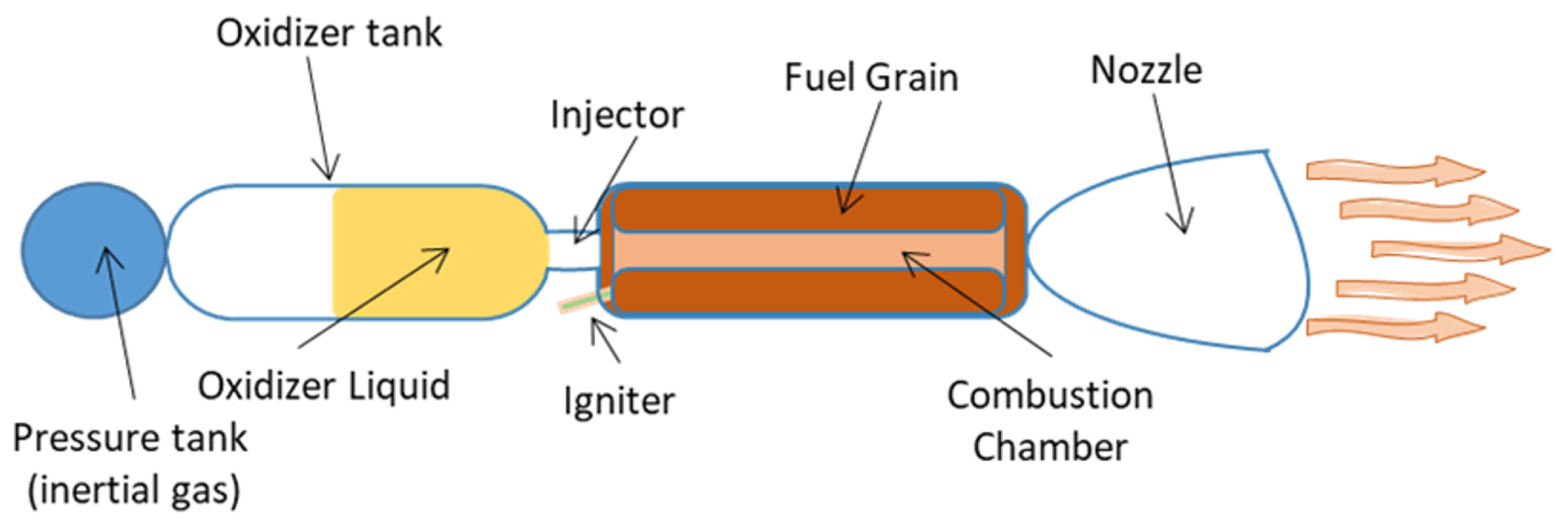
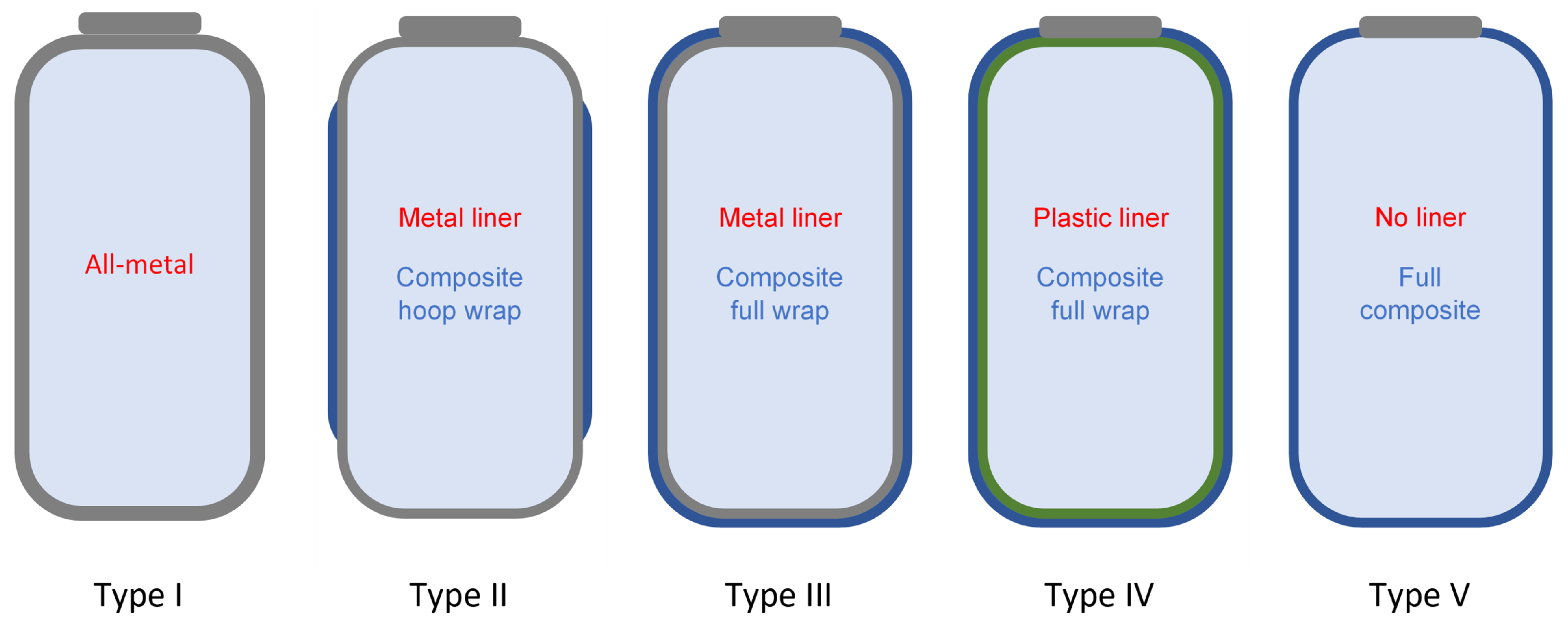
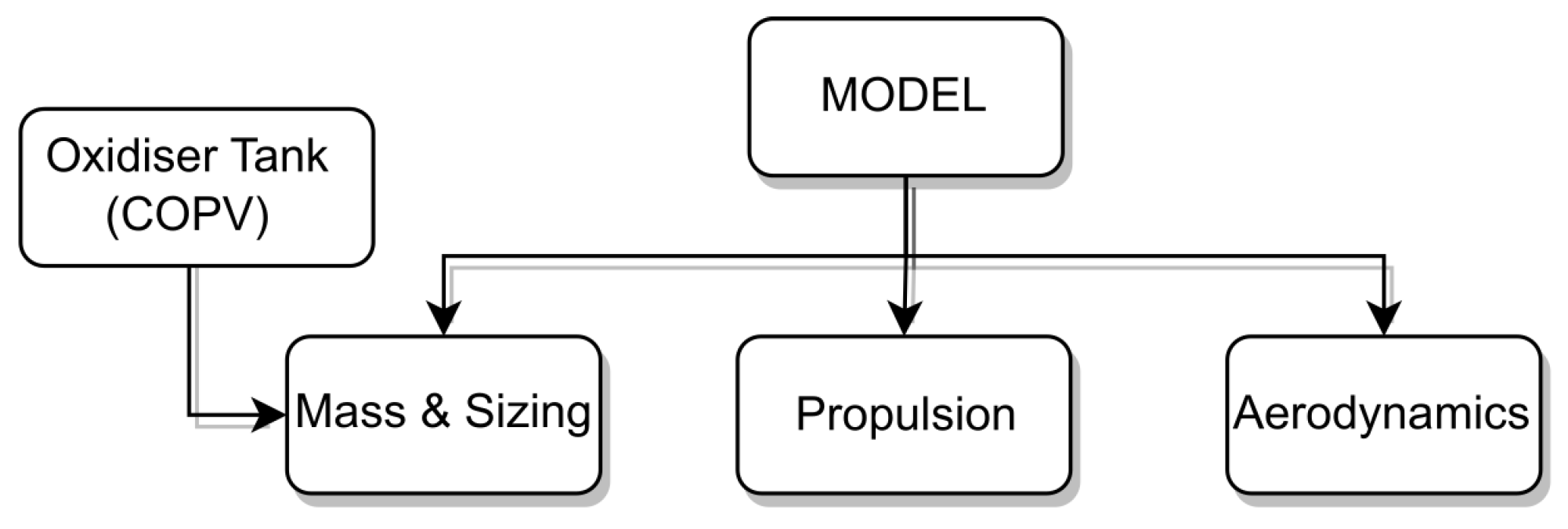







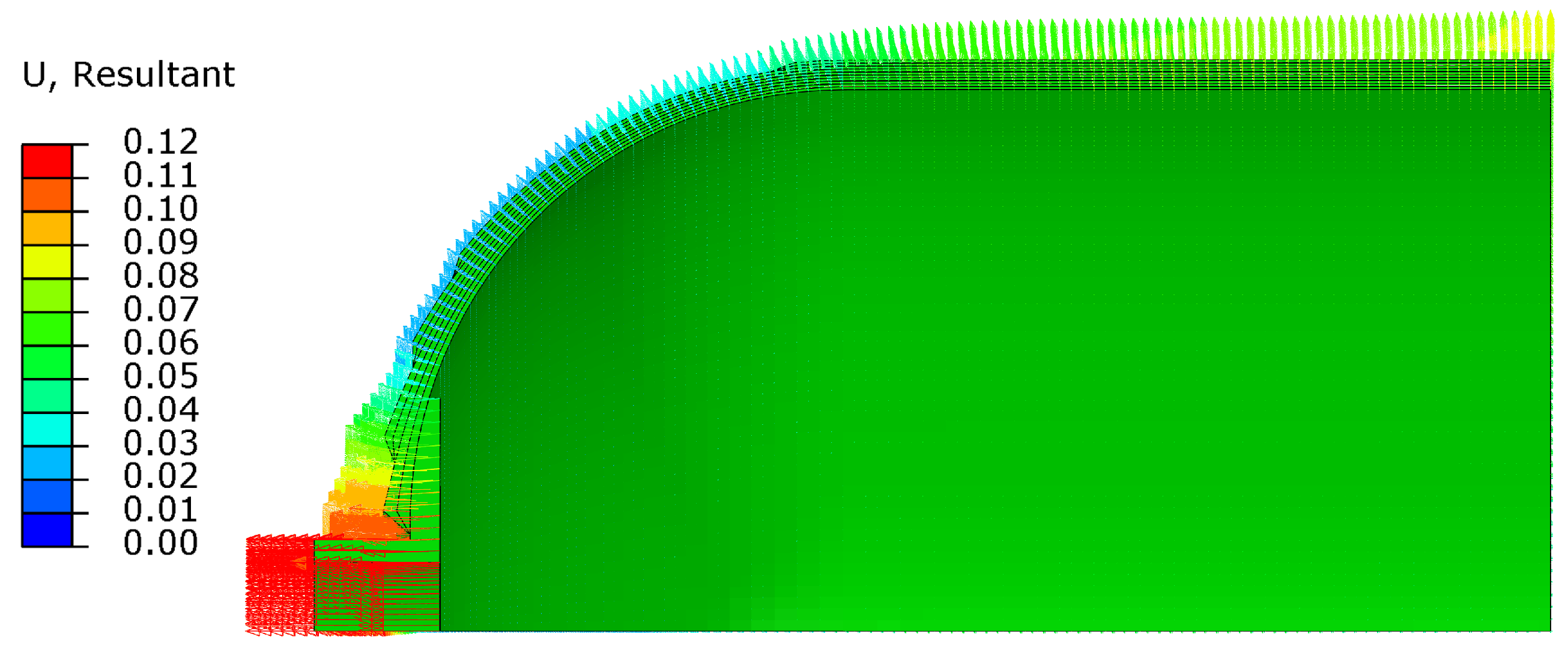


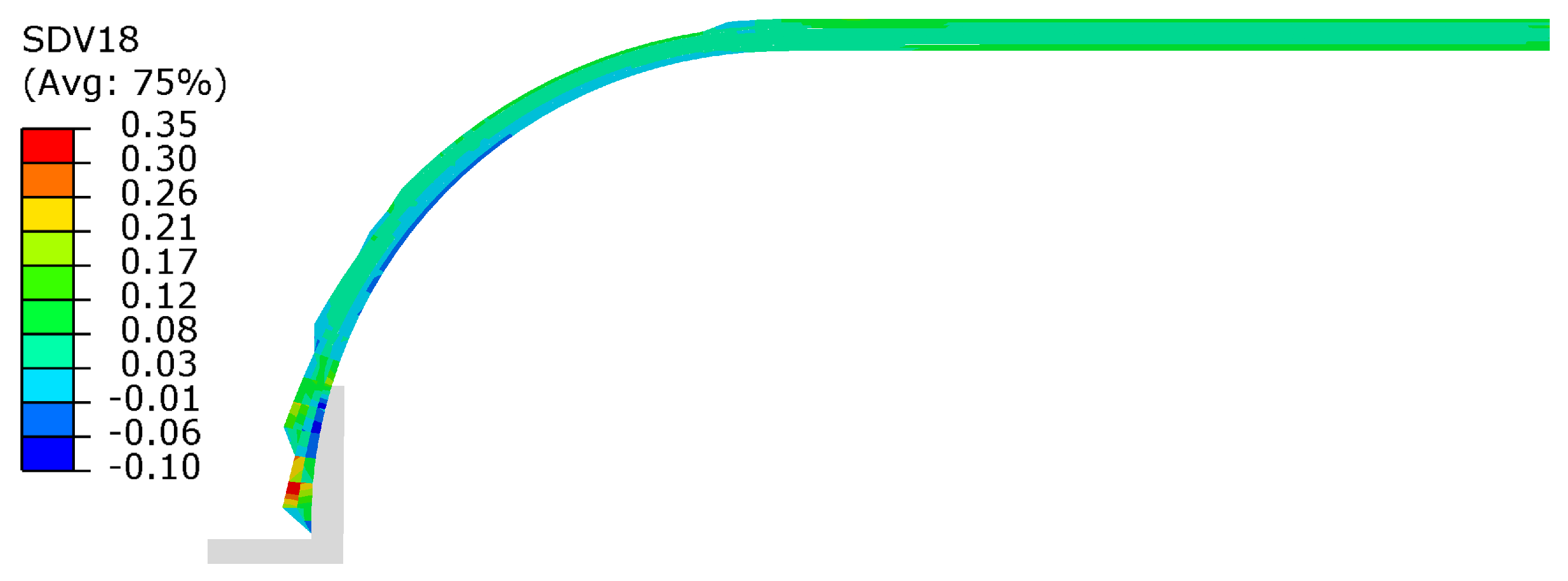


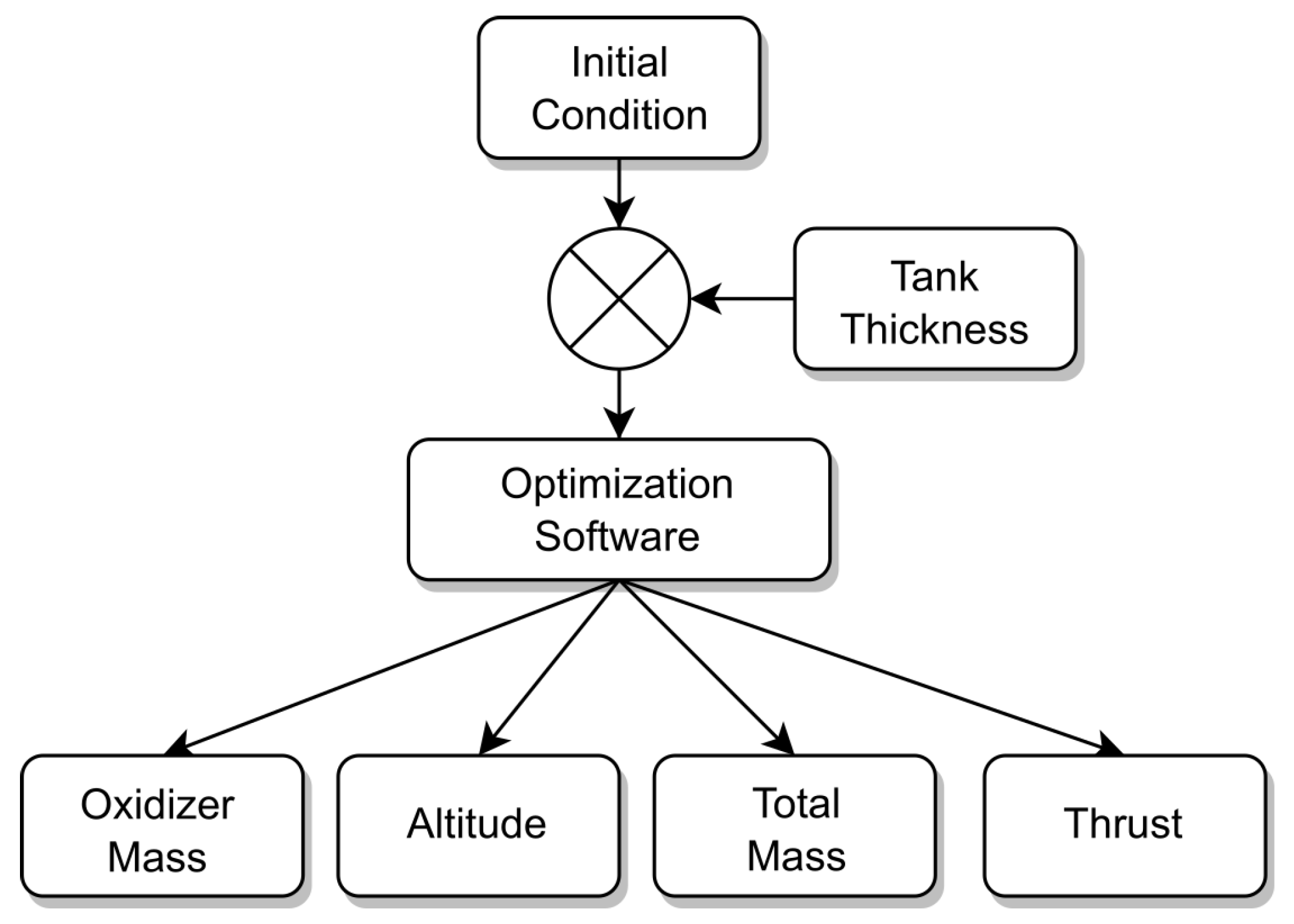
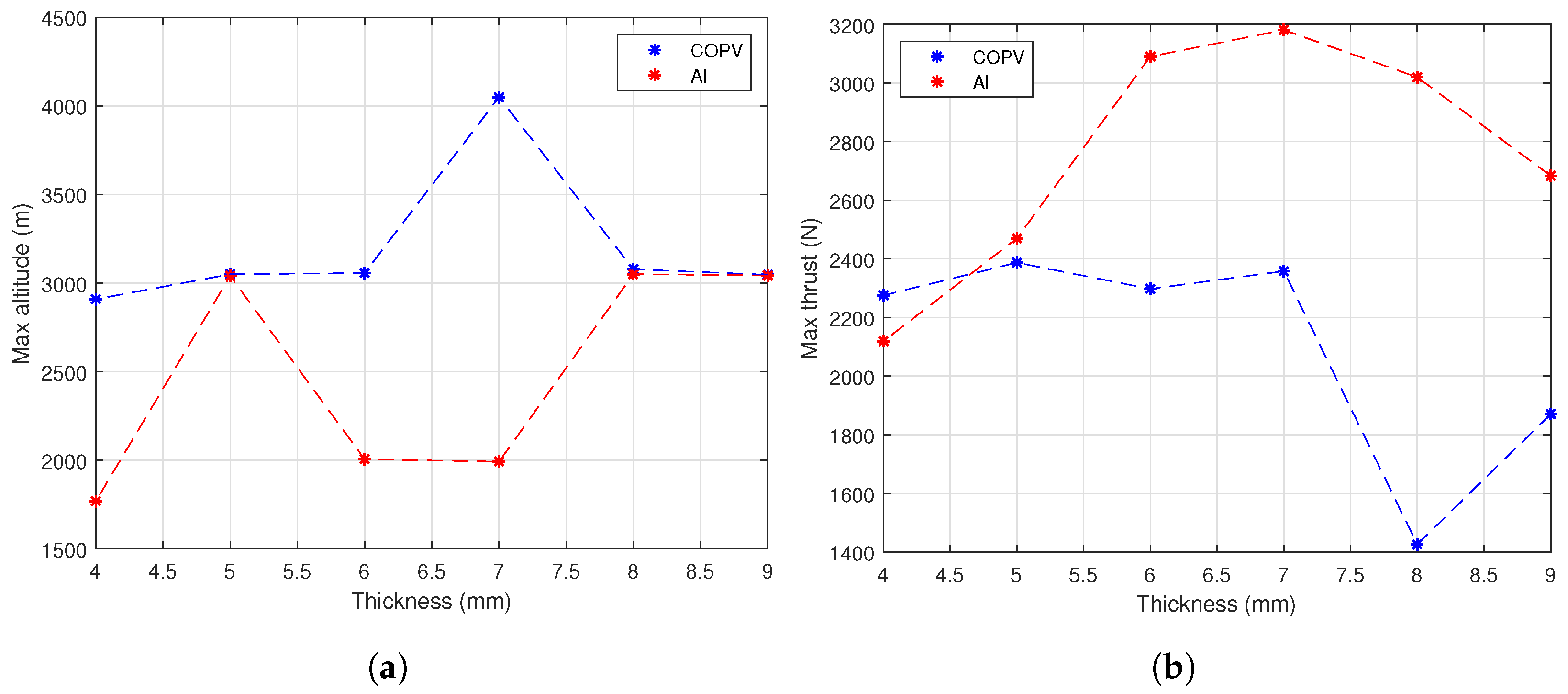

| Symbol | Description | Value | Units |
|---|---|---|---|
| Longitudinal elastic modulus | 171,420 | MPa | |
| Transversal elastic modulus | 9080 | MPa | |
| Longitudinal shear modulus | 5290 | MPa | |
| Longitudinal Poisson’s ratio | 0.32 | n/d | |
| Transverse Poisson’s ratio | 0.4 | n/d |
| Symbol | Description | Value | Units |
|---|---|---|---|
| Longitudinal uniaxial tension | 2323.5 | MPa | |
| Longitudinal uniaxial compression | 1200 | MPa | |
| Transverse uniaxial tension | 62.3 | MPa | |
| Transverse uniaxial compression | 253.7 | MPa | |
| Longitudinal shear | 89.6 | MPa | |
| Transverse shear | 81.1 | MPa | |
| Transverse biaxial tension | 38.7 | MPa | |
| Transverse biaxial compression | 3501 | MPa |
| Variable | Parameter | Values | Units |
|---|---|---|---|
| oxidiser tank volume | 0.012 | m3 | |
| effective injector area | 2.100E-05 | m2 | |
| fuel grain length | 0.200 | m | |
| initial fuel grain port diameter | 0.080 | m | |
| nozzle throat diameter | 0.024 | m | |
| nozzle area ratio as a fraction | 3.000 | - | |
| rocket’s mass | 35.12 | kg | |
| structure length | 3.342 | m | |
| rocket’s external diameter | 0.100 | m | |
| combustion chamber mass | 1.529 | kg | |
| oxidiser tank mass | 3.000 | kg | |
| external structure mass | 6.000 | kg | |
| oxidiser tank length | 1.557 | m | |
| combustion chamber length | 0.500 | m | |
| fin span | 0.059 | m | |
| oxidiser tank radius | 0.051 | m | |
| fin root chord | 0.300 | m | |
| fin tip chord | 0.225 | m | |
| recovery system length | 0.554 | m | |
| avionics system length | 0.303 | m | |
| avionics system mass | 3.241 | kg | |
| recovery system mass | 7.778 | kg | |
| fins mass | 0.199 | kg | |
| nozzle mass | 1.944 | kg | |
| cone mass | 0.817 | kg | |
| distance between nose cone tip and oxidiser tank | 1.858 | m | |
| combustion chamber internal radius | 0.055 | m | |
| fuel mass | 0.855 | kg | |
| oxidiser mass | 6.835 | kg | |
| combustion chamber radius | 0.058 | m | |
| additional mass in the recovery bay | 1.500 | kg | |
| additional mass in the nose cone | 0.000 | kg |
Disclaimer/Publisher’s Note: The statements, opinions and data contained in all publications are solely those of the individual author(s) and contributor(s) and not of MDPI and/or the editor(s). MDPI and/or the editor(s) disclaim responsibility for any injury to people or property resulting from any ideas, methods, instructions or products referred to in the content. |
© 2024 by the authors. Licensee MDPI, Basel, Switzerland. This article is an open access article distributed under the terms and conditions of the Creative Commons Attribution (CC BY) license (https://creativecommons.org/licenses/by/4.0/).
Share and Cite
Souza, A.; Gonçalves, P.T.; Afonso, F.; Lau, F.; Rocha, N.; Suleman, A. On the Multidisciplinary Design of a Hybrid Rocket Launcher with a Composite Overwrapped Pressure Vessel. J. Compos. Sci. 2024, 8, 109. https://doi.org/10.3390/jcs8030109
Souza A, Gonçalves PT, Afonso F, Lau F, Rocha N, Suleman A. On the Multidisciplinary Design of a Hybrid Rocket Launcher with a Composite Overwrapped Pressure Vessel. Journal of Composites Science. 2024; 8(3):109. https://doi.org/10.3390/jcs8030109
Chicago/Turabian StyleSouza, Alain, Paulo Teixeira Gonçalves, Frederico Afonso, Fernando Lau, Nuno Rocha, and Afzal Suleman. 2024. "On the Multidisciplinary Design of a Hybrid Rocket Launcher with a Composite Overwrapped Pressure Vessel" Journal of Composites Science 8, no. 3: 109. https://doi.org/10.3390/jcs8030109






